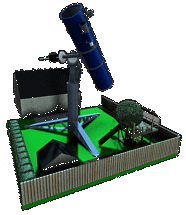 |
 |
|
Filter Research |
Go back to HOMEPAGE
 |
 |
|
Filter Research |
Go back to HOMEPAGE
|
The Great Filter Filibuster There are many books and websites out there that will describe the virtues of using filters to enhance your telescope viewing experience. In my attempt to understand what filters are best to have in my own accessory case and why, I have had to glean small bits of information from many different places. Most sources compare a couple filters to each other, and only a very small number of sources site real measured data instead of qualitative observations. No single website or book compares all the available filters to each other, and tries to explain why one is better than the other. In this web-paper I have attempted to collect and present information about astronomical filters from a purely technical point-of-view. I'm an engineer by trade, so I am more comfortable making comparisons and choices based on real data, which is what I've tried to do here.
Figure 1 An assortment of planetary (colour) filters Filters improve what we see by removing what we don’t want to see from the image. For example a light pollution filter improves the view of faint deep-sky objects by removing the wavelengths of light from city lights, or the contrast of Mars’ blue and red features are improved by using a filter that blocks green light, etc. Regardless of the filter type, they all work by blocking some combination of wavelengths of light. So by knowing what wavelengths of light are being blocked by a filter and by how much, we can determine how affective it might be for a specific application. But where does one get this kind of information?
Figure 2 An example of deep-sky (band-pass) filters The filter property that I am talking about is its spectral response. It is a measure of the percentage of light passed by the filter at each wavelength of light. I have been hunting high and low to gather the spectral responses of as many filters as I can. Most data I have found on the internet, some I got directly from the manufacturer, and some I have figured out myself by experiment. I have grouped my research into two broad filter categories:
My interest in filters is strictly in relation to visual astronomy, so let’s begin with a look at the human eye… <next>
|
||
|
Introduction - The Human Eye - Planetary Filter Research - Using Planetary Filters - Deep-Sky Filter Research - Using Deep-Sky Filters - References |
Go back to HOMEPAGE
Last updated: 07-Mar-12
|
Copyrights to all content from the webpages hosted here belongs to Jim Thompson. Nov. 2009. |